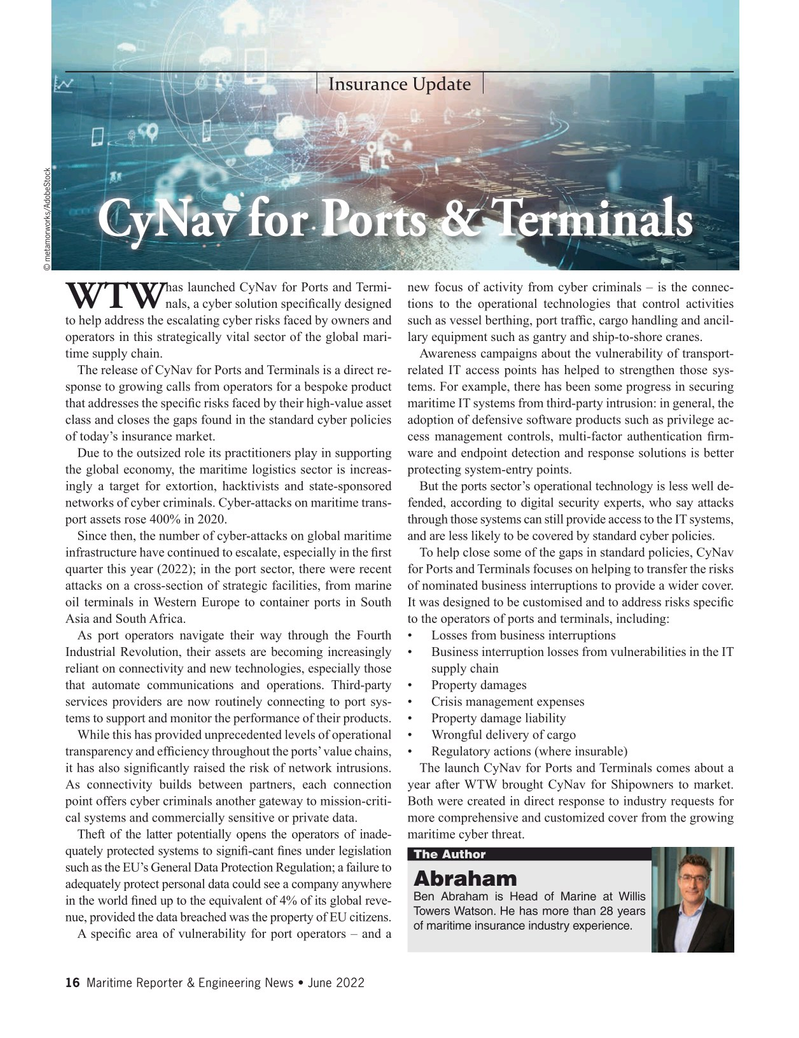
Page 16: of Maritime Reporter Magazine (June 2022)
USCG Fleet Modernization Annual
Read this page in Pdf, Flash or Html5 edition of June 2022 Maritime Reporter Magazine
Insurance Update
CyNav for Ports & Terminals © metamorworks/AdobeStock has launched CyNav for Ports and Termi- new focus of activity from cyber criminals – is the connec-
WTW nals, a cyber solution speci? cally designed tions to the operational technologies that control activities to help address the escalating cyber risks faced by owners and such as vessel berthing, port traf? c, cargo handling and ancil- operators in this strategically vital sector of the global mari- lary equipment such as gantry and ship-to-shore cranes. time supply chain. Awareness campaigns about the vulnerability of transport-
The release of CyNav for Ports and Terminals is a direct re- related IT access points has helped to strengthen those sys- sponse to growing calls from operators for a bespoke product tems. For example, there has been some progress in securing that addresses the speci? c risks faced by their high-value asset maritime IT systems from third-party intrusion: in general, the class and closes the gaps found in the standard cyber policies adoption of defensive software products such as privilege ac- of today’s insurance market. cess management controls, multi-factor authentication ? rm-
Due to the outsized role its practitioners play in supporting ware and endpoint detection and response solutions is better the global economy, the maritime logistics sector is increas- protecting system-entry points.
ingly a target for extortion, hacktivists and state-sponsored But the ports sector’s operational technology is less well de- networks of cyber criminals. Cyber-attacks on maritime trans- fended, according to digital security experts, who say attacks port assets rose 400% in 2020. through those systems can still provide access to the IT systems,
Since then, the number of cyber-attacks on global maritime and are less likely to be covered by standard cyber policies. infrastructure have continued to escalate, especially in the ? rst To help close some of the gaps in standard policies, CyNav quarter this year (2022); in the port sector, there were recent for Ports and Terminals focuses on helping to transfer the risks attacks on a cross-section of strategic facilities, from marine of nominated business interruptions to provide a wider cover. oil terminals in Western Europe to container ports in South It was designed to be customised and to address risks speci? c
Asia and South Africa. to the operators of ports and terminals, including:
As port operators navigate their way through the Fourth • Losses from business interruptions
Industrial Revolution, their assets are becoming increasingly • Business interruption losses from vulnerabilities in the IT reliant on connectivity and new technologies, especially those supply chain that automate communications and operations. Third-party • Property damages services providers are now routinely connecting to port sys- • Crisis management expenses tems to support and monitor the performance of their products. • Property damage liability
While this has provided unprecedented levels of operational • Wrongful delivery of cargo transparency and ef? ciency throughout the ports’ value chains, • Regulatory actions (where insurable) it has also signi? cantly raised the risk of network intrusions. The launch CyNav for Ports and Terminals comes about a
As connectivity builds between partners, each connection year after WTW brought CyNav for Shipowners to market. point offers cyber criminals another gateway to mission-criti- Both were created in direct response to industry requests for cal systems and commercially sensitive or private data. more comprehensive and customized cover from the growing
Theft of the latter potentially opens the operators of inade- maritime cyber threat. quately protected systems to signi? -cant ? nes under legislation
The Author such as the EU’s General Data Protection Regulation; a failure to
Abraham adequately protect personal data could see a company anywhere
Ben Abraham is Head of Marine at Willis in the world ? ned up to the equivalent of 4% of its global reve-
Towers Watson. He has more than 28 years nue, provided the data breached was the property of EU citizens.
of maritime insurance industry experience.
A speci? c area of vulnerability for port operators – and a 16 Maritime Reporter & Engineering News • June 2022
MR #6 (1-17).indd 16 6/6/2022 8:50:16 AM

 15
15

 17
17
